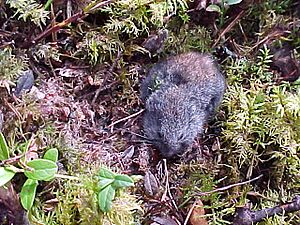Wood lemming facts for kids
Quick facts for kids Wood lemming |
|
|---|---|
 |
|
| A wood lemming hiding on the forest floor | |
| Conservation status | |
| Scientific classification | |
| Genus: |
Myopus
|
| Species: |
schisticolor
|
The wood lemming (Myopus schisticolor) is a small rodent that lives in forests. It belongs to the same family as voles, other lemmings, and muskrats. You can find these lemmings in the cold, northern forests called the taiga. They live in countries like China, Estonia, Finland, Mongolia, Norway, Russia, and Sweden.
Contents
How Wood Lemmings Have Babies
Wood lemmings have a very special way of having babies. They usually have about three times more female babies than male babies! This happens because of a unique genetic system. Some female lemmings have a special genetic makeup that makes them only have female offspring.
Scientists think this might help the lemmings survive better. It could help them find mates and keep their population healthy, especially when there are not many lemmings around.
Wood Lemming Population Changes
The number of wood lemmings in an area changes a lot. Sometimes there are huge numbers of them, and then other years there are very few. When there are too many lemmings in one place, they start to move. This movement, or migration, usually happens from late July to early October.
These migrations are usually short, only a few kilometers. They don't have a specific direction. Sometimes, if the land makes it hard for them to spread out, you might see many lemmings moving at once. There are old stories about lemmings running off cliffs into the sea and drowning. But these are just legends and not true!
Male and female wood lemmings use different amounts of space. Male lemmings roam over areas that are five to seven times larger than the areas females use.
What Do Wood Lemmings Eat?
Wood lemmings mostly eat moss. They especially like certain types of moss, such as Dicranum, Polytrichum, Ptilium, and Pleurozium. Dicranum seems to be their favorite. In places like Northern Finland, Dicranum moss is a very important food for them in winter. These mosses are easy for them to eat and have good nutrients.
Lemmings also eat some types of grass, like Deschampsia. They will also munch on the leaves and stems of Vaccinium plants, which include blueberries and cranberries.
Where Do Wood Lemmings Live?
You can find wood lemmings across the taiga forests of Eurasia. This stretches from southern Norway all the way to the Kamchatka Peninsula in Russia.
Their perfect home is a spruce forest with lots of thick moss covering the ground. Lemmings like places where they can hide from predators. This includes holes in old, fallen trees, tree stumps, and mossy rocks. In the winter, wood lemmings look for drier spots than they use in the summer.
Wood Lemming Activity
Wood lemmings are very good at living in cold places. Their bodies are designed to stay warm, and they have good insulation. Compared to other small rodents, lemmings drink more water. This might be why they look for wetter areas in the spring and summer. Male lemmings travel much farther than females, sometimes four to 12 times more distance.
Reproduction and Life Cycle
Wood lemmings usually have their babies during the winter months. Female lemmings can start having babies when they are quite young, between 22 and 40 days old. Males are ready to breed a bit later, usually around 44 days old, once they weigh about 20 grams.
Female lemmings can have two or three groups of babies each year. Each group, called a litter, usually has three to seven young lemmings. Sadly, most wood lemmings do not live very long. Their average life expectancy is less than one year.


